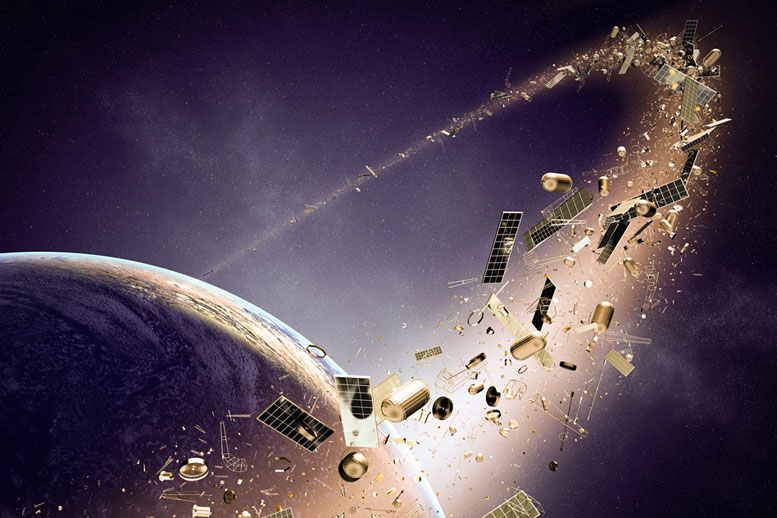Space Junk
By Staff Writer, écoute moi
The space junk is very quickly surrounding the globe. At the moment, the equipment which could trace down junk are not able to spot as to where it accumulated and serious damage to working satellites this can put other satellite at risk. are helping the tracking efforts with a cool laser.
Its consequences: Even tiny flecks of paint can damage a spacecraft when traveling at such high speeds. In the past, windows on the space shuttle have been replaced because of damage caused by paint flecks. Trackers alert that the link and connection services can be disturbed due to the collision. This could be a loss of millions of dollar as a result of which could generate the insurance prices and hinder the functioning and performance.
Space Junk
In the coming years number of satellites will be set up which will immensely result in more spacecraft and therefore more junk floating around the orbit.
- The space is huge so the risk isn’t in number though
- The danger arises when not aware of the satellites which are not used
Right now, the International Space Station is the most heavily protected spacecraft. It can withstand impacts from debris about one centimetre in diameter. If the pilots know a larger object is headed their way, they can move to avoid it. Laser technologies can help identify that bigger, damaging space junk.
The Air Force found out that there are more than 20,000 pieces of space junk, but NASA figured out that there are lot of small chunks of junk that could damage satellites that are active or working in sphere. Currently, a few industries are coming up to recover the loss and gain returns from satellite and junk tracking.
Space Junk
LeoLabs — which triggered the panic about the thinkable strike a few days ago — plans to have six ground-based radars to track pieces of space junk down to 2 centimeters.
NorthStar Earth and Space is looking forward to starting the first of its space junk-tracking satellites as soon as they are able to make about $ 38 million next year in 2018.
Rest are busy assembling statistics derived by companies so that they are able to forecast and make satellite tracks. The MIT and ESA teams will need to figure out how much weight to give to each of these satellite characteristics. To get all of the information they need, the teams plan to use publicly available data that companies share on the license applications for their spacecraft. These include the orbits that a satellite is going to, for instance, as well as disposal plans. Wood says the teams might also develop questionnaires that operators can fill out about their spacecraft. “They can choose what to share and what not to share,” she says. “They’ll have to make a choice: would I rather get a better rating or hide information, basically.”
Space Junk
Once the rating system is decided, the teams will come up with an algorithm that evaluates how a satellite or constellation might affect other vehicles in space. And it’s possible that when all of this is complete, a new entity, perhaps a non-profit, will be tasked with overseeing those scores. “We’re here to help design the operations and we’ll have to decide through the design process what entity will actually execute it,” says Wood.
“Near Earth space does require environmental protection.”
Wood sees this tool as a way for companies and operators to enhance their image, by having a good SSR score. It’s also something that could be useful for companies that insure spacecraft, as the SSR could be a good guide for evaluating the liability of a satellite.
But above all, the goal is to come up with another way to keep Earth orbit a functioning place. If too many collisions and debris muck up space, certain orbits could become unusable. And that means we could potentially lose certain capabilities that rely on satellites, from satellite TV and communications to Earth observations and space research. That’s one major reason why Jah and Wood are working on the SSR, as it would provide another way of protecting space as if it were an ecosystem.
“Near-Earth space does require environmental protection,” says Jah. “It’s not necessarily like climate change thing, but it is a global commons, which could suffer a tragedy of the commons if we don’t do something.”
Space Junk
Right now, e.Deorbit doesn’t have the financing and support it needs to launch. Meanwhile, millions of euros worth of satellite hardware remains at risk from collision, and there are people at risk too. The International Space Station makes regular maneuvers to avoid space debris over 10 centimeters in size. To protect the astronauts against smaller debris that can still do fatal damage, the engineers have built them a kind of coat of armour.
The drive to keep space debris at bay is growing as more satellites are launched. Today there are around 2,000 active spacecraft, either in low Earth orbit or far away in geostationary positions. Distant satellites are simply ‘parked’ in graveyard orbits at the end of their lives, while satellites closer to Earth come back home, breaking apart, as can be seen in a unique video of the ATV re-supply ship re-entering the atmosphere over the south Pacific. d
